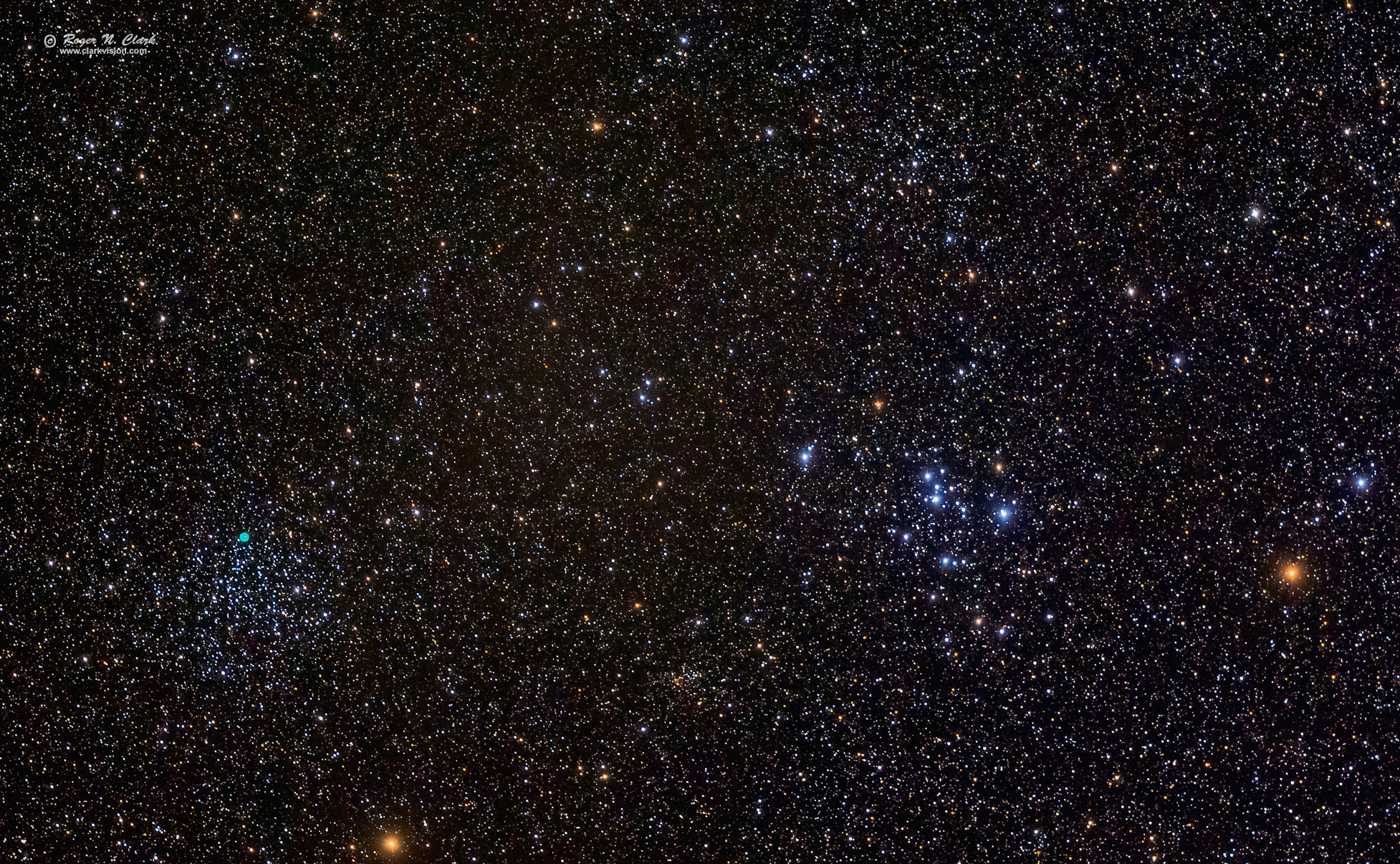| Home | Galleries | Articles | Reviews | Best Gear | New | About | Contact | Gallery Index | Previous |
Next |

| Home | Galleries | Articles | Reviews | Best Gear | New | About | Contact | Gallery Index | Previous |
Next |

M47 (NGC 2422) and M46 (NGC 2437) are open clusters in the constellation Puppis. In the image, M47 is on the right, and M46 with the planetary is on the left. The planetary is green due to emission from oxygen. These clusters are a beautiful sight in a single view in binoculars or wide field telescope. The planetary nebula NGC 2438 in M46 is a nice sight in amateur telescopes, like 6 to 8-inches aperture. M46 is about 300 million years old and about 5,500 light-years distant. M47 is younger, estimated to be less than 80 million years old and only 1,600 light-years distant. Slightly below the line between M46 and M47 is the small and old open star cluster NGC 2425. It is estimated to be 2.5 billion years old, and the stars in the cluster are cooler (yellow-orange). Cooler stars have longer lives than blue stars. Above M47 is the open star cluster NGC 2423. Note the patch of burnt-orange interstellar dust between these clusters.
Technical. This image was obtained with a Canon 7D Mark II 20-megapixel digital camera and 300 mm f/2.8 L IS II lens at f/2.8 and ISO 1600. No dark frame subtraction, no flat fields. Tracking with an Astrotrac and no guiding. The 27 minutes total exposure (27 1-minute exposures). The image is 60% of full resolution.
Post processing: stretched with rnc-color-stretch. Also see Astrophotography Image Processing Basic Work Flow.
This is a natural color image. The high dynamic range of astrophotos must be stretched to bring out the range of details the camera recorded. But the typical image stretch process loses color for brighter subjects (e.g. stars and the brighter parts of deep sky objects become whiter as they are made brighter). To process this image I used a new algorithm, rnc-color-stretch that does not lose color during the stretch. How do we know the colors are reasonable? The star colors can be checked against stellar photometry. The star color diversity is impressive in this region of the sky. Note the orange stars, which have B-V of 1 to about 2. The blue-white stars have B-V in the range of about 0 to -0.5. The colors closely follow the color sequence in Table 1 at Color of Stars. Solar-type stars have a B-V of 0.63 and appear close to white (daylight white balance).
The Exposure Factors, CEF, CEFA are measures of the relative amounts of light received from a subject. It can be used to fairly compare wildly different lens/telescope apertures and exposure times. For this image:
Modern DSLRs like the 7D Mark II include on sensor dark current suppression and low fixed pattern noise at ISOs around 1600 and higher, making no need for dark frame subtraction. Modern raw converters correct for light fall-off and also correct for hot/dead/stuck pixels. This makes processing low light images easy: simply align and average.
To learn how to obtain stunning images like this, please visit my Extensive Articles on Photography .
See my review of the Canon 7D Mark II and why it is so good for astrophotography: Canon 7D Mark II sensor analysis.
Keywords to this image = astrophoto-1 star_cluster nebula Messier night low-light digital_astro canon_7d2 rnc-color-stretch
Image ID: m46+m47.c02.01.2016.0J6A6942-73-av27.a-1500-rs20,2.e-1954s.jpg
| Home | Galleries | Articles | Reviews | Best Gear | Science | New | About | Contact |
Last updated April 02, 2025